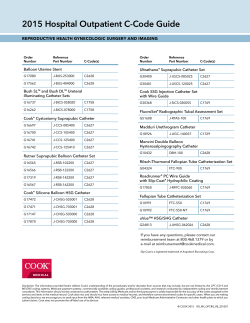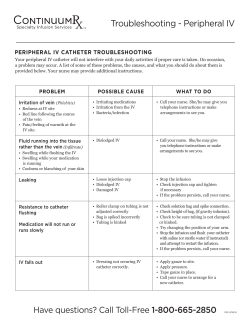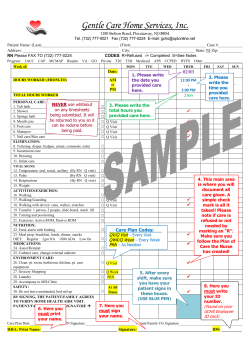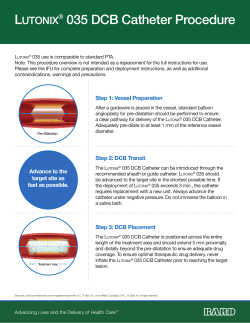
Post-Operative Care Information
ATTENTION: ANIMAL CARE STAFF Post-Operative Care Information - Surgical Models Catheterizations Customer Date of Surgery Harlan No. Surgeon(s) Quantity Male RESET FORM Ship Date Customer Requests Female Stock/Strain Requested Age/Weight DOB Surgical Facility 202 231 237 Surgical Procedure Catheter Volume* (mL) Plugged End Catheter Inside Diameter Needle Size (Best Fit Inside Catheter) Jugular Vein Catheterization (JVC)* 0.05 .025”/0.6mm 22 gauge Carotid Artery Catheterization (CAC)* 0.03 .025”/0.6mm 22 gauge Femoral Vein Catheterization (FVC)* 0.07 .025”/0.6mm 22 gauge Femoral Artery Catheterization (FAC)* 0.06 .025”/0.6mm 22 gauge Portal Vein Catheterization via Superior Mesenteric Vein (PVC)* 0.08 .025”/0.6mm 22 gauge Bile Duct Catheterization Closed Loop (BDCCL) 0.10 .025”/0.6mm 22 gauge Other Other * Standard Harlan catheter exteriorization is a fixed 2.5cm exposed length between the shoulder blades; catheter is round-tipped, and made of polyurethane. Dimensions apply to standard catheterization option only. Catheter volumes are approximations only. Catheter Exteriorization Options Options Part No. Volume (mL) PinPort™ Harness Drug Treatment Dosage Ketamine/Xylazine 41.7 mg Ket + 8.3 mg Xyl/kg 200 mg Ket + 10 mg Xyl/kg Isoflurane To effect Inhalation Ketoprofen 3.0 mg/kg 5.0 mg/kg SQ Culex Catheter Vascular Access Port (VAP) Other Catheter Lock Solution Options Other Last dose of analgesia given on Heparin-Glycerol Solution (10:90 ratio) 500 IU Heparin/1 mL final solution in Glycerol Heparin-Saline Solution 500 IU Heparin/1 mL final solution in Saline Other Dietary Supplementation Standard diet ad libitum Standard water ad libitum Other IM IM Heparin/Glycerol solution supplied by: http://www.sai-infusion.com/products/ catheter-locking-solutions Standard Lock Solution: Heparin-Glycerol (50:50 ratio) 500 IU Heparin/1 mL final solution in Glycerol Route Notes IP IP SQ ATTENTION: ANIMAL CARE STAFF Harlan Surgically-Modified Animals: Catheter Maintenance Recommendations 1. 2. 3. 4. 5. Individually house animals with exteriorized catheters. Provide animals with food and water ad libitum. Maintain animals in a clean, stable environment. Closely examine animals’ incision(s) a minimum of 72 hours after receipt. Incision sutures or wound clips should remain for a minimum of seven days postsurgery. Reapply new sutures or wound clips on animals kept longer than seven days post-surgery, or as needed. 6. Continue aseptic catheter maintenance to preserve patency, per the recommendations. 7. Immediately prior to shipping, catheters are evaluated by our surgical staff for integrity and complete patency. 8. Clients must notify Harlan Laboratories within 24 hours of delivery for credit/ replacement of animals exhibiting abnormal behavior or moribundity or deceased on arrival. Bile Duct Catheterization: Bile Duct Catheterization Post-Operative Care Instructions Materials Needed Per Catheter for Evaluating Patency • Trained personnel or commercial animal restraint device • Locking, non-traumatizing forceps or hemostatic clamp • One 22/23 gauge luer stub adapter • One sterile 1 mL syringe • Collection tube for bile • 70% isopropyl alcohol • Iodine solution • Sterile gauze sponges • Sterile saline for injection • A second sterile stainless steel catheter coupler Procedure for Evaluating Bile Duct Catheter Patency 1. For accurate and safe handling of the animal, two trained people or a commercial animal restraint device should be used. 2. Catheter patency checks should be performed immediately upon animal arrival and every 24 hours thereafter. 3. Catheters should be examined for signs of leakage immediately upon arrival and every 24 hours thereafter. 4. Bile flow is from the animal’s left to the right. 5. Wipe the ends of the catheter around the coupler with iodine solution-soaked gauze sponge, followed by a wipe of a 70% isopropyl alcohol-soaked gauze sponge. Discard sponges. 6. Clamp the right side of the catheter loop. Remove the coupler and discard. Bile should flow from the animal’s left side catheter. 7. Insert an adapter on a syringe filled with sterile saline into the right side catheter. Remove the clamp. 8. Slowly inject 0.10 mL of saline into the duodenal end (right side). Re-clamp this catheter end before removing the needle/syringe. Discard needle/syringe. 9. Following patency check, the catheter loop (and flow of bile to the intestine) is re-established by joining the two pieces of tubing over a sterile catheter coupler. Ensure there are no air bubbles at the inserted coupler end in the catheter, as bubbles can impede the natural flow of the bile. Vascular Catheterizations: Vascular Catheterization Post-Operative Care Instructions Depending on the customer defined surgical model, complete heparin maintenance and aseptic catheter flushing as specified below: I. Standard Option – Fixed; 2.5cm Exteriorized • Complete heparin maintenance following two to four days acclimation. • Evaluate patency every five to seven days thereafter. II. PinPort • Complete heparin maintenance following three to four days acclimation. • Evaluate patency every seven days thereafter. • Follow the specific flushing instructions for PinPorted animals on the sheet provided with your order “Post-Operative Care Information-CatheterizationsPinPort Maintenance.” III. Harnessed • Complete heparin maintenance following two to three days acclimation. • Evaluate patency every two to three days thereafter. • Maintain positive pressure on syringe plunger when removing the syringe from the harness. IV. Culex Catheter • Complete catheter heparin maintenance upon arrival. • Evaluate patency every three to four days thereafter. V. Vascular Access Port (VAP) • Complete catheter heparin maintenance upon client receipt. • Evaluate patency every three to four days thereafter. • Maintain positive pressure on syringe plunger when removing the syringe from the port. • Note: Dermal application of antibacterial moisturizing cream to the VAP access site is recommended after each access. Materials Needed Per Catheter for Evaluating Patency • Trained personnel or commercial animal restraint device • Two locking, non-traumatizing forceps or hemostatic clamps • Three 22/23 gauge luer stub adapters (for Std. Option), OR non-coring needles (Huber for VAPs; SN22 for buttons & harnesses) OR three 19 gauge luer stub adapters (for Culex catheters) • Three sterile 1 mL syringes • Sterile locking solution (Standard 500 IU/mL Heparin/Glycerol Locking Solution supplied by SAI Applications, Inc.) • Sterile saline for injection • 70% isopropyl alcohol • Iodine solution • Sterile gauze sponges • A second sterile stainless steel catheter plug Procedure for Evaluating Vascular Catheter Patency 1. For accurate and safe handling of the animal, two trained people or a commercial animal restraint device should be used. 2. Wipe the catheter plugged end/harness port/skin over VAP with iodine solutionsoaked gauze sponge, followed by a wipe of a 70% isopropyl alcohol-soaked gauze sponge. Discard sponges. 3. When clamping the catheter, use non-traumatizing forceps or hemostats; clamp catheter on the tubing, proximal to the stainless steel plug/harness. Using a second pair of locking forceps or hemostats, with gentle, steady force remove the stainless steel plug from the catheter. Discard plug. 4. Insert the luer stub adapter/non-coring needle on an empty syringe into the catheter tip (or port) and remove the clamp. 5. Withdraw lock solution. Collect at least 0.10 mL of blood into syringe to ensure all locking solution is aspirated from the catheter. 6. Reclamp the catheter and remove the adapter/needle and syringe. Discard. 7. Insert a different adapter/non-coring needle on another syringe containing sterile saline into the catheter and remove the clamp from the catheter. 8. Slowly inject 0.20 mL sterile saline into standard and Culex catheters, or 0.30 mL saline into harnessed and VAP implants. Reclamp the catheter. 9. Remove the adapter/needle and syringe and discard. Insert a different adapter/noncoring needle on a third syringe containing catheter locking solution. 10.Remove the clamp from the catheter and inject the lock solution into the catheter with the pre-determined volume as indicated on the table on previous page. 11.Clamp the catheter then remove the adapter/needle and syringe and discard. Insert three-fourths of the length of a second sterile stainless steel plug into the end of the catheter. Remove the clamp. www.harlan.com | Corporate Headquarters: 8520 Allison Pointe Blvd. Suite 400, Indianapolis, IN 46250 Harlan, Harlan Laboratories, and the Harlan logo are registered trademarks of Harlan Laboratories, Inc. PinPort is a trademark of Instech Laboratories, Inc. © 2015 Harlan Laboratories, Inc. RMS0215-US-EN-02-PS-296
© Copyright 2025









